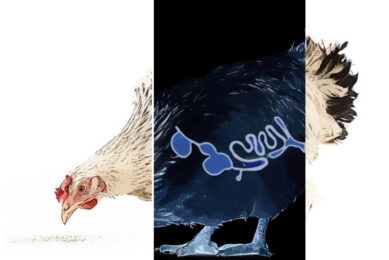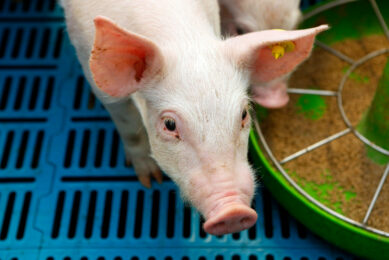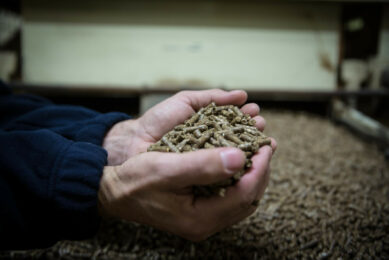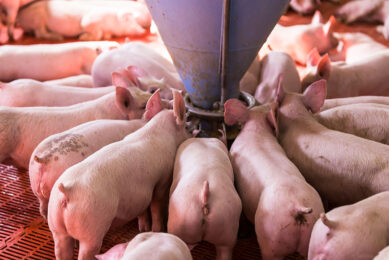How feeding can support intestinal health (2)
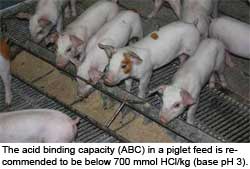
Salmonella continues to be an important cause for disease. Every now and then it emerges from its slumbering state and causes headlines in the papers when food has been contaminated and vulnerable groups become ill. Apart from strict hygiene measures, feeding strategies can also contribute to diminishing salmonella incidences. In Part 2 of this series of two, the use of acids and other possible feed additives is discussed.
By Heinrich Kleine Klausing and Georg Riewenherm, Deutsche Tiernahrung Cremer, Germany
In addition to the feed structure the selective reduction in the acid binding capacity of feed and adding organic acids or their salts contributes in supporting intestinal health. This is especially true when it comes to eradicating gram-negative bacteria such as salmonella and E. coli. Before dealing with the acids, it is worth taking a closer look at the “acid-binding capacity” (ABC), which is a measure for the binding capacity of feed. In a piglet feed it is now recommended to be below 700 mmol HCl/kg (base pH 3) ABC.
This can be reached via various measures, such as limited calcium content (<0.85%) and the concurrent use of phytase, the use of “alternative sources of calcium” such as calcium formiate, and limiting the crude protein level to maximum 18% (in starter and grower feeds, not in prestarter) while using synthetic amino acids.
Especially the use of organic acids which dissociate predominantly in the stomach, have a reducing impact on ABC. This way a 0.5% formic acid addition reduces feed pH with about 0.9 and ABC with approximately 50 mmol HCl per kg of feed. Also in grower feeds ABC can be lowered by reducing Ca and P levels (0.75% and 0.45% respectively) and the use of phytase to secure P-digestability from plant derived phytate. This promotes a good acidification of the feed in the stomach fluid, and the corresponding pH decrease. With the most important mode of action one must first distinguish the differences between inorganic acids (e.g. phosphoric acid) and organic acids (e.g. formic acid, lactic acid, benzoic acid, propionic acid, and citric acid). Inorganic acids have only a pH effect due to the release of H+ ions (pH = negative decimal logarithm of the H+ ion concentration). Organic acids possess in addition to the pH effect an anion, which has a direct inhibitory effect on potential harmful bacteria such as salmonella. In feeds the pH reduction has an antimicrobial effect, which is mainly beneficial to storage stability of the feed. In the stomach pH regulating influences the microflora (“barrier effect”) and activates pepsin for optimum protein digestion. In addition, the anion or, if not yet dissociated, the whole acid molecule regulates the intestinal flora. Various organic acids are particularly effective against gram-negative bacteria – salmonella and E. coli. Furthermore, the salts of organic acids are worth mentioning (such as calcium formiate, calcium lactate, potassium formiate). These do not have a pH-reducing effect on the acid anion, but an antimicrobial effect. In addition, these are highly digestible sources of minerals in piglet feeds.
Formic acid is effective
Over the past few years extensive work has been carried out on the effectiveness of acids on salmonella. In these works, in particular, the formic acid has been shown to be effective. Mathies and Rimbach (2007) for formic acid against Salmonella choleraesuisgive a MIC value (minimal inhibitory concentration) of 1.0 ml per mg (base: pH 5). For propionic acid, in comparison, a value of 3.0 mg per ml is specified. Also benzoic acid has shown in vitro to be of interest with a MIC value of 0.8 mg per ml. However, it should be noted in comparison with the other organic acids that benzoic acid mainly dissociates in the duodenum down to the caecum, which makes is not suitable to regulate stomach pH.
“Protected” acids, MCFA, probiotics and prebiotics
So-called encapsulated or protected acids constitute a further development of common organic acids. These are provided with a fat coating which delays the dissociation of the acid molecules in the stomach. Enzymes dissolve the fat coating efficiently in the small intestine and there the time-delayed release and dissociation of the acid molecules takes place. This way pH regulation and anion effect can be executed as a more targeted stabilising effect on digestion and the natural gut flora. Due to this mechanism, the encapsulated acids are particularly effective in supporting the prevention against salmonella. In broilers successful lower detection rates of salmonella in faecal samples have been established using encapsulated buteric acid.
In recent years, especially in the poultry sector studies with medium-chain fatty acids (MCFA C6, C8, C10) have been carried out, which showed a reduction of salmonella excretion in deliberately infected chickens in comparison to the not infected control group.
The influence of probiotics on the prevalence of salmonella has been frequently studied. Especially fermented feeds with an increased concentration of lactic acid bacteria and lactic acid showed positive results in Denmark. A similar situation exists with the so-called prebiotics – oligosaccharides such as oligofructose, inulin, mannans – which in the duodenum cannot be broken down by the body’s enzymes. In the caecum these are available as a food for bifido bacteria and promote the formation of short-chain fatty acids such as propionic and butyric acids. The above additives imply that their effectiveness is in close relation to the administered amount. And for various products such as probiotics, animal nutrition dosages are regulated which are bound to follow. Simultaneously, these products must be subjected to a cost comparison with the proven measures such as improving feed structure and the use of organic acids based on cost per produced pig or cost per kg meat.
Recommendations for a “low salmonella diet”
In finishing farms with a salmonella problem the following nutritional measures can be taken in addition to accompany management measures:
• Nutrient content starter feed:
13.0 – 13.4 MJ ME per kg; 17 – max. 18% crude protein; 1.10 – 1.15% lysine; max. 0.8% Ca, 0.55% P; phytase
• Nutrient content grower/finisher feed:
13.0 – 13.4 MJ ME per kilogram; about 16 – max. 17% crude protein; 0.9 – 1.0% lysine; max. 0.8% Ca; 0.45 – 0.5% P; phytase recommended
• Feed structure:
Mash feed preferred
Feed structure: “Coarse” with at least 25 to 30% of particles > 1.4 mm according to current knowledge.
• Grinding technology:
Required screen size depends of the used mill equipment (no. of sieves; speed regulation) in the feed mill or on the farm. When home mixing the technical quality of the screens and hammers should be regularly checked. Screen size is less important than hammer quality. Worn, chipped hammers produce a fine meal with high dust content – even on coarse screen size.
Acid use
0.8% formic acid or an acid mixture from formic acid and e.g. lactic acid or propionic acid; alternatively also salts of formic acid (e.g. calcium formiate or potassium formiate) can be used, but must be used in higher doses or in combination with formic acid, or mixtures of the salts can be used. It is to be noted that in many countries the use of potassium formiate is regulated to a maximum inclusion. In prophylactic use to promote intestinal health, a dosage of 0.3-0.5% formic acid or a formic acid based mixture is sufficient.
In summary
The targeted reduction of salmonella prevalence in pig meat production is a shared responsibility of all participants in the production chain. Food and feeding are not primarily the responsible source. Feed and feeding are not the main responsible sources for salmonella entrance in the chain. However, these can significantly contribute to gut health with specified measures and thus support other management instruments (e.g. targeted animal supply, eliminating specific vectors, hygiene measures) at the farm.
Translated and adapted from Agriculture and Veterinary Academy “Practical pig farming”, Horstmar, Germany. Website: www.ava1.de (in German)
Source: AllAboutFeed vol 1 nr 3, 2010




